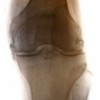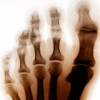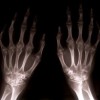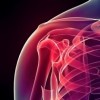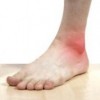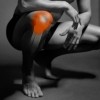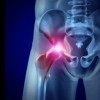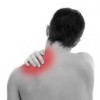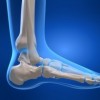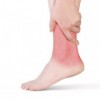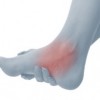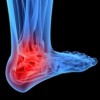Conditions
Rheumatoid Arthritis in the knee
Rheumatoid arthritis (RA) is a relatively common condition affecting three times more women than men and normally developing between the ages of 40 to 50, although it can affect people at any age. RA has the ability to develop in any joint of the body but most commonly it affects the wrists, hands, ankles and feet. It normally develops symmetrically affecting the same joint on both sides of the body.
Symptoms begin as joint and muscle stiffness, particularly in the early mornings with symptoms starting to ease 2-3 hours after getting up. After a few weeks the same joints that have been stiff may become painful and swollen. The pain will feel like a deep throbbing ache that is aggravated by rest and certain levels of activity. The swelling levels during a flare up also cause the skin around the joint to be extremely tender and slightly warm to the touch.
Rheumatoid Arthritis in the Foot
Rheumatoid arthritis (RA) is a relatively common condition affecting three times more women than men and normally developing between the ages of 40 to 50, although it can affect people at any age. RA has the ability to develop in any joint of the body but most commonly it affects the small bones of the feet, wrists and hands. It normally develops symmetrically affecting the same joint on both sides of the body.
Symptoms begin as joint and muscle stiffness, particularly in the early mornings with symptoms starting to ease 2-3 hours after getting up. After a few weeks the same joints that have been stiff may become painful and swollen. The pain will feel like a deep throbbing ache that is aggravated by rest and certain levels of activity. The swelling levels during a flare up also cause the skin around the joint to be extremely tender and slightly warm to the touch.
Rheumatoid Arthritis in the Wrist and Hand
Rheumatoid arthritis (RA) is a relatively common condition affecting three times more women than men and normally developing between the ages of 40 to 50, although it can affect people at any age. RA has the ability to develop in any joint of the body but most commonly it affects the wrists, hands, ankles and feet. It normally develops symmetrically affecting the same joint on both sides of the body.
Symptoms begin as joint and muscle stiffness, particularly in the early mornings with symptoms starting to ease 2-3 hours after getting up. After a few weeks the same joints that have been stiff may become painful and swollen. The pain will feel like a deep throbbing ache that is aggravated by rest and certain levels of activity. The swelling levels during a flare up also cause the skin around the joint to be extremely tender and slightly warm to the touch.
Subacromial bursitis most commonly occurs as a result of injury normally due to a repetitive strenuous activity involving repetitive overhead reaching or compression through the shoulder, such as lying on it or falling with your arm outstretched. These factors put more pressure over the bursa, irritating it and triggering a painful inflammatory reaction (swelling). The risk of developing bursitis is greater in those whose jobs or hobbies involve repetitive overhead movements, like painters and decorators. Symptoms normally include a constant dull ache or burning pain over the shoulder joint, which is aggravated by any touch, pressure or movement. There may be noticeable swelling around the front of the shoulder.
In cases of bursitis caused by infection, the skin around the affected joint will appear to be red and will feel incredibly warm to the touch. Additional symptoms are a high temperature and feverish chills.
Retrocalcaneal bursitis most commonly occurs as s result of repetitive activity that encourages the calf muscles to tighten and shorten from overuse, like repetitively wearing high heels, running and even wearing tight shoes that pinch at the back of the heel. Symptoms normally include a constant dull ache or burning pain at the back of the heel that is aggravated by any touch or pressure from tight shoes or movement of the ankle joint. There will normally be noticeable swelling around the back of the heel. In cases of bursitis caused by infection the skin around the affected joint will appear red and will feel incredibly warm to the touch. Additional symptoms are a high temperature and feverish chills.
Retrocalcaneal bursitis is very similar to Achilles bursitis as the bursae are very close in proximity and symptoms are almost identical however retrocalcaneal bursitis is a lot more common.
Pre-patellar bursitis, also known as housemaid's knee, most commonly occurs as a result of injury from continuous pressure, such as kneeling or repetitive strenuous activity. These factors put more pressure over the bursa, irritating it and triggering a painful inflammatory reaction (swelling). This risk of developing bursitis is greater in those whose jobs or hobbies involve a lot of repetitive kneeling, for example carpet fitters and gardeners.
Symptoms normally include a constant dull ache or burning pain over the knee cap, which is aggravated by any touch, pressure or movement of the knee joint. There will normally be noticeable swelling around the front of the knee. In cases of bursitis caused by infection the skin around the affected joint will appear to be red and will feel incredibly warm to the touch with additional symptoms of a high temperature and feverish chills.
Slipped Capital Femoral Epiphysis
A slipped capital femoral epiphysis can affect both sides at the same time and most commonly occurs in boys aged 11 -15. In particular it most commonly occurs in children who are obese or very tall and thin going through sudden and rapid growth spurts. It is estimated that the condition affects 2 out of every 100,000 children, making it one of the most common hip complaints in children.
In cases related to trauma the child will feel a very intense, immediate sharp pain around the hip and groin. The child will not be able to weight bear making walking excruciating it may be that one leg is slightly shorter than the other. In the cases where the onset is gradual the child may have been complaining of pain and stiffness around the hip for weeks or months. They might be limping very slightly with the limp worsening as the pain worsens.
Thoracic outlet syndrome (TOS) most commonly occurs either as a result of severe sudden trauma or as a gradual repetitive trauma. The most common sudden trauma related to TOS is whiplash. Repetitive trauma normally occurs through slouched poor posture, often caused by poor office ergonomics. Other types of work like army training with compressive heavy weighted back packs or activities that involve repetitive overhead stretching such as certain sports like swimming and weightlifting can also cause TOS.
In most cases there is a gradual onset of symptoms, most commonly starting with pain at the side of the neck that refers down into the arm and hand. The pain can be a dull ache or burning sensation that can amount to a sharp pain particularly on arm movements. Some cases begin with hand pain or hand symptoms, such as pins and needles, tingling or numbness.
Sinus tarsi syndrome is a relatively common condition. It is most often seen in people who have hypermobile or weak ankles and suffer from repetitive ankle sprains. It is also commonly seen in people whose arches have fallen and have very flat feet.
Symptoms can be a very intense, immediate sharp pain or dull ache around the outside of the ankle. The pain can at times radiate up into the lower leg or further down into the foot. The pain will be accompanied by local swelling and possibly bruising and will be incredibly tender to touch. Pain levels will be aggravated by any side to side foot movements and in particular walking and running on uneven surfaces. Stiffness and dull aches are normally experienced during the night and are most intense early in the mornings easing with movement.
Tibialis anterior tendonitis is a common injury normally seen in individuals who partake in athletic sports that involve repetitive or forceful upwards flexion of the ankle and foot. Typically activities like uphill or downhill running and sprinting, walking on uneven surfaces and sports such as snowboarding (long periods on toe side) can trigger the onset.
Symptoms begin with a dull ache around the front of the ankle that gradually worsens over a course of 2-3 weeks. In some cases the discomfort is only felt on ankle dorsiflexion, when the tibialis anterior tendon is stressed, with others it is felt once resting after an activity. Stiffness and dull aches are normally experienced during the night and are most intense early in the morning. The pain and discomfort will often radiate from the front of the ankle, up into the lower leg and down into the top of the foot.
Tibialis posterior tendonitis is a common injury normally seen in individuals who partake in athletic sports that involve repetitive or forceful tilting inwards and downwards flexion of the ankle and foot.
Symptoms begin with a dull ache around the inside of the ankle that gradually worsens over a course of 2-3 weeks. In some cases the discomfort is only felt on ankle inversion or plantar flexion when the tibialis posterior tendon is stressed, with others it is felt once resting after an activity. Stiffness and dull aches are normally experienced during the night and are most intense early in the morning. The pain and discomfort will often radiate up into the inside of the lower leg or down into the top of the foot.
Posterior ankle impingement is a common injury and effects people of all ages. It is normally seen in individuals who partake in sports that involve repetitive or downwards flexion of the foot, such as football, gymnastics and ballet dancing.
Symptoms include intense immediate sharp pains or dull ache around the back of the ankle when flexing the foot in a downwards movement. Pain can be felt when simply weight bearing or when resting after an activity. Stiffness and dull aches are normally experienced during the night and are most intense early in the morning. The pain at the back of the ankle occasionally radiates up into the calf and down into the sole of the foot.

